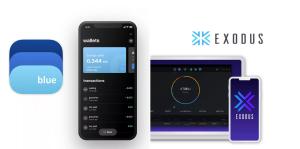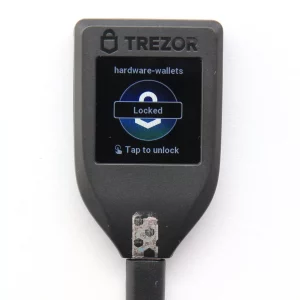A Bitcoin address is used to receive and send Bitcoin transactions on the network. It is a string of alphanumeric characters, typically presented in the form of a QR code for easier scanning. It acts as your public receiving address for Bitcoin transactions. Anyone can send Bitcoin to this address, but only you can access the Bitcoin sent there with your private key.
Unlike email addresses, Bitcoin addresses aren’t tied to accounts or identities. They are essentially cryptographic hashes derived from public keys, acting as gateways for receiving bitcoin.
Lightning Addresses vs. Bitcoin Addresses
While standard Bitcoin addresses facilitate direct on-chain transactions, a newer technology called Lightning Network uses Lightning addresses to facilitate faster and cheaper off-chain transactions. Lightning addresses are human-readable address that are similar to an email address. For instance, you might have a Lightning Address like [email protected]. However, they cannot directly receive on-chain bitcoin, making them distinct from standard Bitcoin addresses.
Read more: What Are Lightning Addresses?
How Bitcoin Addresses Work
Every Bitcoin address is associated with a pair of cryptographic keys: a public key and a private key. The public key is used to generate the address, through cryptographic calculations called hashing, which is shared publicly and serves as an identifier for receiving funds. The private key is kept secret and is used to sign transactions, proving ownership of the associated Bitcoins.
While public keys are like a bank account number (anyone can see them), private keys are like the debit card and PIN (kept secret for secure access). The public key, derived from the private key, forms the basis of the Bitcoin address. Anyone can send bitcoin to an address, but only the holder of the corresponding private key can spend it. Importantly, Bitcoin addresses are not case-sensitive, meaning 1A1zP1eP5QGefi2DMPTfTL5SLmv7DivfNA and 1a1zp1ep5qgefi2dmptftl5slmv7divfna represent the same address.
When someone wants to send Bitcoin to your address, they create a transaction that includes your address as the destination. To spend the funds received at an address, you use your private key to sign a transaction. The signature ensures the network that the owner has authorized the transfer.
When you spend a portion of your funds from an address, the remaining balance is often sent back to a new address controlled by your wallet. This new address is known as a change address. Change address makes it harder to track your entire spending history to a single address, and it helps prevent accidental overspending. It also simplifies future transactions because you can easily spend the change without having to manually calculate and include it in the next transaction amount.
Types of Bitcoin Address
Bitcoin addresses come in several types, each with its own format, benefits, drawbacks, and characteristics. Here are some key types:
Legacy Addresses (P2PKH)
These are the original and still widely used addresses. Transactions involving these addresses are referred to as Pay-to-Public-Key-Hash (P2PKH). They are less space-efficient than newer address types. They start with “1”. Here’s an example: 1a1zp1ep5qgefi2dmptftl5slmv7divfna.
Legacy addresses are widely supported by most Bitcoin wallets and Bitcoin exchanges, ensuring compatibility with various Bitcoin services. However, Legacy addresses come with drawbacks. Transactions involving these addresses may incur higher fees compared to newer formats like Segregated Witness (SegWit), as they result in larger transaction sizes. Additionally, the scripting language used in Legacy addresses is less efficient, limiting the implementation of certain advanced features such as multi-signature and escrow.
SegWit Addresses
There are two main types of SegWit or Segregated Witness addresses: Native SegWit (bech32) and Nested SegWit (P2SH). SegWit is a Bitcoin protocol upgrade that improves transaction efficiency and scalability. It separates transaction signatures from transaction data, reducing the size of transactions and allowing for more transactions to fit into a block.
Native SegWit (Bech32)
Native SegWit addresses have lower transaction fees and improved scalability compared to Legacy and Nested SegWit. Additionally, Native SegWit addresses contribute to increased transaction throughput by efficiently using block space, addressing network congestion during high-demand periods. While they provide future-proofing for upcoming Bitcoin protocol upgrades, you should be mindful of potential compatibility issues, as not all wallets and services may support this format.
These Bitcoin addresses start with “bc1q”: bc1qar0srrr7xfkvy5l643lydnw9re59gtzzwf5mdq.
Nested SegWit Addresses (P2SH-SegWit)
Nested SegWit was introduced in 2017 to address certain scalability and flexibility issues. They enhance security and transaction efficiency, with addresses starting with “3”. Here’s an example: 3KF9nXowQ4asSGxRRzeiTpDjMuwM2nypAN. These addresses are backward-compatible with older wallet software that doesn’t support native SegWit.
Despite lower fees compared to Legacy addresses, they still incur higher fees than Native SegWit addresses, limiting their cost-efficiency. Their larger transaction size results in less efficient use of block space, offering fewer scalability benefits than Native SegWit. While providing some security improvements over Legacy addresses, Nested SegWit doesn’t match the security features of Native SegWit, and its usage is dependent on legacy infrastructure.
Read more: SegWit Explained
Taproot Addresses
Taproot was launched in November 2021 as a Bitcoin protocol upgrade. It enhances privacy, reduces transaction fees, and introduces smart contract flexibility by combining multiple spending conditions into a single address.
Taptoor address starts with “bc1p”. Here is an example: bc1p0xlxvlhemja6c4dqv22uapctqupfhlxm9h8z3k2e72q4k9hcz7vq5zuyut.
In the traditional Bitcoin setup, if you wanted to create a multi-signature wallet that required two out of three private keys to spend funds, you would generate three different addresses—one for each participant. When spending, you’d need to use the specific address corresponding to the condition being met (e.g., two out of three keys required). In a Taproot-enabled scenario, you can combine these conditions into a single address, making it more compact and efficient.
While Taproot offers significant advantages for the Bitcoin network, it’s not without potential drawbacks or challenges. Older wallets may not support Taproot addresses, potentially limiting accessibility for some users. Taproot is still relatively new, and its full potential will only be realized as adoption increases. Wallets with Taproot addresses include Samourai and Coldcard hardware wallet.
Read more: Taproot Explained
Bitcoin Address Privacy, Tracing, and Anonymity
Despite misconceptions, Bitcoin addresses are pseudonymous, not completely anonymous. Each address is a randomly generated string of alphanumeric characters. These addresses are not directly linked to individuals or their real-world identities. However, it can be relatively easy to link multiple addresses together and track their transactions on the public blockchain. This is especially true if: you reuse the same address, which creates a pattern and makes it easier to identify your activity, you buy or sell Bitcoin through KYC exchanges, linking your identity to your Bitcoin address. Finally, blockchain analysis tools can connect addresses based on transaction patterns and behavior.
For enhanced privacy and security, Bitcoin wallets can generate and manage multiple addresses. This allows users to keep transactions separate and avoid reusing the same address, which can potentially increase traceability.
There are various additional options to enhance your privacy, such as CoinJoin and PayJoin. CoinJoin is a method that allows multiple users to combine their Bitcoin transactions into a single transaction. This process makes it challenging for external observers to determine which inputs correspond to which outputs. Bitcoin wallets supporting CoinJoin include Wasabi wallet, Samourai wallet, and Trezor hardware wallet.
PayJoin, on the other hand, is a more recent privacy improvement. It allows two parties in a Bitcoin transaction, typically a buyer and a seller, to collaborate and create a transaction with multiple inputs and outputs. The primary goal is to obscure the payment flow by making it difficult to identify the actual payment among multiple inputs and outputs. This technique enhances privacy by introducing ambiguity in the transaction history. Wallets supporting PayJoin include Wasabi wallet, BlueWallet, and Coldcard hardware wallet.
Certain wallets prioritize user privacy by incorporating features such as stealth addresses and Tor integration. Stealth addresses use cryptographic techniques to create unique, one-time addresses for each transaction, making it difficult for observers to link transactions to a specific recipient. Tor integration in wallets allows users to connect to the Bitcoin network through the Tor network, concealing their IP addresses. Wallets supporting Tor include Phoenix wallet, Mycelium wallet, Samourai, and BlueWallet.
Understand Bitcoin Addresses for Effective Transactions
To get a Bitcoin address, you need to download a Bitcoin wallet that supports the Bitcoin address/es of your choice. Bitcoin addresses are your unique identifiers for sending and receiving Bitcoin. They are not directly tied to identities, making Bitcoin transactions pseudonymous. However, they can be traced through blockchain analysis. Different types exist, offering varying levels of efficiency, security, and privacy. Understanding different types of Bitcoin addresses is key to secure and effective use of Bitcoin.



























